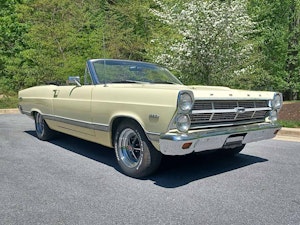Media | Articles
Why you need to drive your classic, and how to get it back on the road
I used to go to the gym five days per week without fail. My workout plan was solid consisting of both weight and cardio training. I started training back in my early twenties, but as I got older and life came into play, I found it challenging to maintain the regimen that I once called a religion. In my thirties, the gym was still very much a part of my life, but again, work, the house and family obligations, pushed it farther back in my weekly routine. Now in my mid-forties, the idea of slapping three-plates on each side of a bench press bar is foreign, but come hell or high water, that doesn’t mean I’m not going to try. You see I’ve been down this road before, letting my body sit idle until my mind tells me it’s time to restart its engine.
Classic cars, like our bodies, are machines. They require exercise, maintenance, and fuel along with a lifetime supply of TLC to keep them running. And while they’re not always easy to maintain, a little bit of care from time to time can mean the difference between a long and healthy life, and one that’s filled with headaches and grief. It’s the same as keeping a fitness habit versus the bigger task of getting into shape.
Let me explain.
I’ve been fortunate to own a variety of vehicles, with each appealing to a different part of my psyche. I’ve acquired them over twenty years and as such; they’ve received various degrees of upkeep and maintenance. My all-time favorite is my 1968 Dodge Charger. It’s my rock and a car that I used to drive regularly. At its peak, I’d put nearly 10,000 miles on the odometer per year driving it in cross country rallies, on road courses, and even to an occasional car show. In recent years other vehicles have come in and out of my life and have taken precedence, thus leaving the Charger parked under a cover with little, if anything, in the way of maintenance being done.
To be clear, this is the exact opposite of how I usually operate. In hindsight, I may have let the Charger sit because it’s always been so reliable, or maybe it’s just that I needed a break. Either way, it’s now time to resurrect the old boy and give it the attention it deserves to turn it back into the machine I fell in love with more than fifteen years ago. On the outside, the car still looks good despite a front end that’s been peppered with rock chips during our 60,000-mile journey together. The paint overall, while still beautiful, shows some flaws and cracks. The wheels that were once polished aluminum, have now faded. Under the hood, things look okay; however, I know deep down that a thorough inspection is in order before any extended drives take place.
Marketplace
Buy and sell classics with confidence

The fact is, regardless of their age, cars want to be driven. It’s what they were designed to do, and it keeps them in a healthy state. That’s why when it comes to classics, I’d rather road-trip a high mileage vehicle that’s been driven and maintained as opposed to a low mileage example that’s gone through life as a show pony. From a collectible standpoint I understand the allure of a well cared for, low-mileage vehicle as everything from the paint and interior are generally in better shape. There’s also the “it’s only original once” mentality, however, as someone who drives his cars, that doesn’t much matter to me. In fact, in many cases, low mileage cars have to undergo mechanical restorations due to many of their components deteriorating over time due to storage and or lack of use.
For me, extended storage is defined as anything more than a year without proper vehicle operation. That means not only starting and running the car but also driving it for some time for all the parts to reach correct operating temperature (that’s about 10-15 miles). This gives all of the vehicles rotating and dried components ample time to lubricate and swell, along with providing the battery sufficient time to charge.
Long periods of non-usage means things will start to break down. Your battery will drain, rubber hoses and fuel lines can become brittle, engine seals dry out, metal components will corrode, tires can also develop flat spots and drive belts can crack. There is also the possibility (depending on how and where the vehicle was stored) of rodent or insect infestation (which is just icky), rust, and in regards to the interior, mold or heat damage.
If you fall into this extended storage club, fear not. It’s not the end of the world. It just means you’ve got some steps to take before you crank that engine over. Follow them, and you should be fine. Ignore them, and you could very well wind up with leaks, breakdowns and even electrical fires. You’re also the only one that knows how the car was initially stored, thus, you’ll need to remember that mental checklist to determine precisely what needs to be done before you get your vehicle back on the road.
Below is a list of six steps that I would recommend to everyone who is bringing their vehicle out of long-term storage.
Step 1: Inspection

Grab a flashlight and do a visual inspection of the cabin, under the hood, and around the vehicle. What you’re looking for is anything that seems out of the ordinary. Are there any leaks, are the oil and transmission pans dry, is the rear end weeping? Do the tires have the right amount of air, is there dry rot and are the wheels torqued correctly? Then turn your attention to the wires. How do they look – are they frayed or chewed upon, and is there evidence of outside contaminants such as acorns, twigs or leaves that may indicate rodents anywhere in the engine compartment? I bring this up because what many folks don’t realize is that in some cars, the sheathing used on the wires has a soy-based coating, which tastes like popcorn to rodents, so make sure you give it a thorough once-over.
Tasty wiring aside, rodents can still make a mess of things. Example; I once found a chipmunk nest in the airbox of my old Kawasaki ZX7 sportbike. The little guys had climbed through the ram-air ducts and packed away enough nuts for the entire winter. Thus, just because you don’t see something initially, that doesn’t mean it’s not there.
In regards to the interior – look underneath the dash, again, checking to see if everything looks as is should. Feel the carpets for any moisture that may have gotten in and check the interior panels for mold. When this is done, proceed to check the body itself. This is especially important if the vehicle was stored outside as moisture from the ground will rise and cause rust and rot without you ever noticing. I’ve seen cars develop rust on the rockers, floor pans and especially around the rear window and door jams after sitting outside under a cover for less than a year, so be mindful.
Step 2: Fuel

Once you’ve completed your visual inspection, it’s time to turn your attention to the fuel. Here in California, our fuel is terrible, with 91 octane being the maximum available at the pump. It also contains ethanol (as does most of the pump gas in the U.S.), which isn’t classic car friendly as it does absorb water. The problem is not the ethanol itself, but the moisture it conducts can cause corrosion in your fuel tank and carburetor, along with possibly damaging engine seals if a vehicle is stored for extended periods. Thus, if your car is stored for a year or more, I would highly recommend draining out the old fuel with a siphon, and then adding some fresh fuel before the key is turned. This may be overkill to some, however, in regards to my personal cars, I’d instead do this, and be safe than sorry.
Step 3: Suspension

Next up, suspension. Jack up the car, place jack stands underneath, then crawl under with a grease gun and attach it to anything with a grease fitting. What your doing here is making sure that everything from your sway bars and tie rods ends, to the ball joints, are sufficiently lubricated. Once done, wipe off any excess grease and you’ll be good to go. Oh, and while you’re down there, it’s probably a good idea to check your shocks to see if there’s any leakage.
Step 4: Fluids
20180320201444)
This one’s easy – check your fluids – oil, power steering, brake, transmission, and antifreeze. As for changing them, honestly, it’s subjective and dependent upon how you initially stored the vehicle in the first place. For instance, if the oil was changed before the car being stored, and even after a year, I’d have no problem running it. However, in the case of my Charger, I’m not sure when I last swapped it out, therefore, an oil change is in order along with a new high-quality filter. If the other fluids look okay, they’ll be topped off, and that should be that. (You’ll want to revisit some of these fluids later if you plan to keep driving the car regularly.)
Step 5: Fire it up
20180320205502)
Now that the fluids have been checked/changed, your battery charged, tires checked, and wheels torqued, it’s finally time to turn the key. If you’re the current owner of a classic car that runs a carburetor than you know that after sitting, the initial startup might be problematic. If it doesn’t crank immediately and you’re worried about draining your battery, simply shoot a few squirts of starter fluid into the carb, and that should help to fire it up. If this doesn’t work, grab a test light and go through the checklist: spark, fuel, and compression. I’ve seen everything from coils to fuel pumps work before storage, and then for no apparent reason, crap out when the time came to enjoy the vehicle again.
Step 6: The shakedown run
20180320205838)
Now that everything is complete and the vehicle running, it’s time for a test drive. The key here is to start slow. Get yourself out on the road and go for a leisurely ride of about five miles or so paying particular attention to your gauges. Once done, pull back into the driveway, pop the hood and check for leaks from the carburetor, power steering pump, brake lines, radiator, thermostat housing along with any other extra oil and transmission coolers that have been added to the vehicle. If everything checks out, then it’s now time for a longer run. This time, get on the gas to see if the timing is dialed in and how the car performs as a whole. Once complete, check again for leaks and if it all looks good then pull that sucker out of storage for the long haul and enjoy.
Some of you will think that the above is overkill, which is a shame, as the fact is our classics are just that–classics. In many cases, they still contain much of their original components. So while it may take the better part of an afternoon to bring your car out of hibernation properly, the payoff, if done correctly, will be great.
Did I miss anything? Do you have any of your own storage stories? Please share them below in the Hagerty Forums.
20180320201127)









